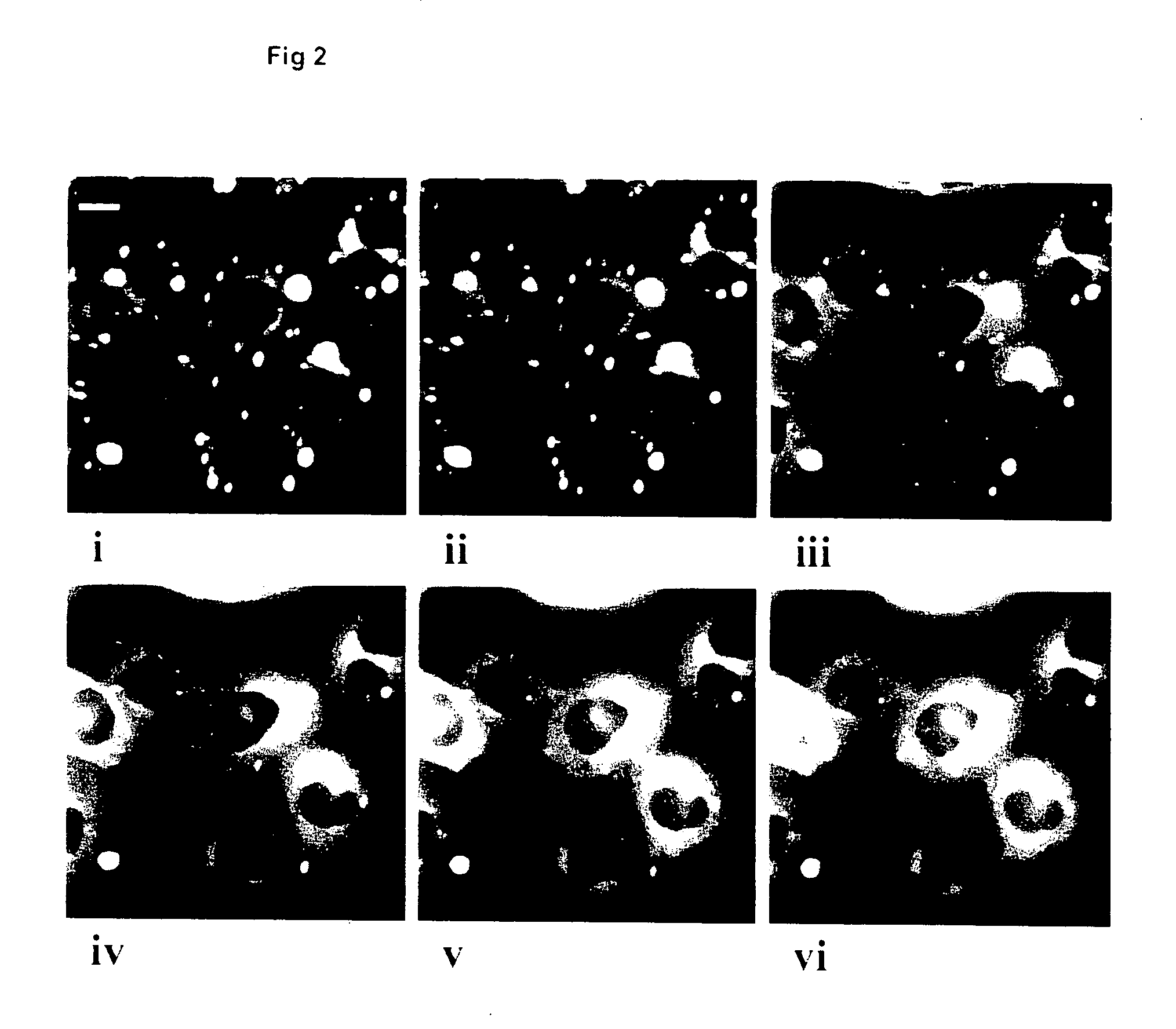Method for extracting quantitative information relating to an influence on a cellular response
a quantitative information and cellular response technology, applied in the field of methods and tools for extracting quantitative information relating to an influence, can solve the problems of cumbersome highly invasive techniques, difficult to obtain detailed knowledge on e.g. exact timing and spatial characteristics of signalling events, and inapplicability to large-scale screening of biologically active substances
- Summary
- Abstract
- Description
- Claims
- Application Information
AI Technical Summary
Benefits of technology
Problems solved by technology
Method used
Image
Examples
example 2
Quantitation of Redistribution in Real-Time within Living Cells
Probe for Detection of PKC Activity in Real Time within Living Cells:
Construction of PKC-GFP Fusion:
[0153]The probe was constructed by ligating two restriction enzyme treated polymerase chain reaction (PCR) amplification products of the cDNA for murine PKCα (GenBank Accession number: M25811) and F64L-S6ST-GFP (sequence disclosed in WO 97 / 11094) respectively. Taq® polymerase and the following oligonucleotide primers were used for PCR;
[0154]
5′mPKCa: (SEQ ID NO: 5)TTggACACAAgCTTTggACACCCTCAggATATggCTgACgTTTACCCggC CAACg,3′mPKCa: (SEQ ID NO: 6)gTCATCTTCTCgAgTCTTTCAggCgCgCCCTACTgCACTTTgCAAgATTg ggTgC,5′F64L-S65T-GFP: (SEQ ID NO: 1)TTggACACAAgCTTTggACACggCgCgCCATgAgTAAAggAgAAgAACTT TTC,3′F64L-S65T-GFP: (...
example 3
Probes for Detection of Mitogen Activated Protein Kinase Erk1 Redistribution
[0161]Useful for monitoring signalling pathways involving MAPK, e.g. to identify compounds which modulate the activity of the pathway in living cells.
[0162]Erk1, a serine / threonine protein kinase, is a component of a signalling pathway which is activated by e.g. many growth factors.
Probes for Detection of ERK-1 Activity in Real Time within Living Cells:
[0163]The extracellular signal regulated kinase (ERK-1, a mitogen activated protein kinase, MAPK) is fused N- or C-terminally to a derivative of GFP. The resulting fusions expressed in different mammalian cells are used for monitoring in vivo the nuclear translocation, and thereby the activation, of ERK1 in response to stimuli that activate the MAPK pathway.
a) Construction of Murine ERK1-F64L-S65T-GFP Fusion:
[0164]Convenient restriction endonuclease sites are introduced into the cDNAs encoding murine ERK1 (GenBank Accession number: Z14249) and F64L-S65T-GFP (s...
example 4
Probes for Detection of Erk2 Redistribution
[0173]Useful for monitoring signalling pathways involving MAPK, e.g. to identify compounds which modulate the activity of the pathway in living cells.
[0174]Erk2, a serine / threonine protein kinase, is closely related to Erk1 but not identical; it is a component of a signalling pathway which is activated by e.g. many growth factors.
[0175]a) The rat Erk2 gene (GenBank Accession number: M64300) was amplified using PCR according to standard protocols with primers Erk2-top (SEQ ID NO:11) and Erk2-bottom / +stop (SEQ ID NO:13) The PCR product was digested with restriction enzymes Xho1 and BamH1, and ligated into pEGFP-C1 (Clontech, Palo Alto; GenBank Accession number U55763) digested with Xho1 and BamH1. This produces an EGFP-Erk2 fusion (SEQ ID NO:40 &41) under the control of a CMV promoter.
[0176]b) The rat Erk2 gene (GenBank Accession number: M64300) was amplified using PCR according to standard protocols with primers (SEQ ID NO:11) Erk2-top and E...
PUM
| Property | Measurement | Unit |
|---|---|---|
| Lifetime stability | aaaaa | aaaaa |
| Resonance energy | aaaaa | aaaaa |
| Biological properties | aaaaa | aaaaa |
Abstract
Description
Claims
Application Information
 Login to View More
Login to View More - R&D
- Intellectual Property
- Life Sciences
- Materials
- Tech Scout
- Unparalleled Data Quality
- Higher Quality Content
- 60% Fewer Hallucinations
Browse by: Latest US Patents, China's latest patents, Technical Efficacy Thesaurus, Application Domain, Technology Topic, Popular Technical Reports.
© 2025 PatSnap. All rights reserved.Legal|Privacy policy|Modern Slavery Act Transparency Statement|Sitemap|About US| Contact US: help@patsnap.com



